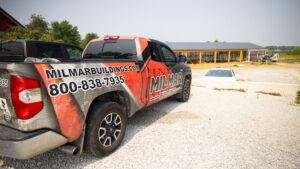
The Importance of Venting Eaves and Ridges in Your Post-Frame Building
Why do eaves and ridges need to be vented and how does it work?
Without adequate ventilation, the pole barn can experience moisture build-up, heat retention, and structural deterioration.
When it comes to constructing a post-frame building, proper ventilation is often overlooked.
Venting eaves and ridges is an essential practice that not only protects the interior of the building from weather elements, but also enhances its aesthetic appeal.
However, there are common misconceptions and questions surrounding this topic that needs to be addressed.
What are Eaves and Ridges?
In pole barn construction, eaves refer to the edges of the roof that overhang the walls of the building.
Some buildings have no overhangs, but the practicality of that draw air up and through the roof system without allowing rain or bugs to get into the building.
They play a vital role in protecting the interior of the pole barn from weather elements and providing an aesthetic appeal.
On the other hand, ridges are the highest points on the roof where the panels meet. They also serve a critical structural component of the pole barn.
The Need for Ventilation in Pole Barns
Proper ventilation is essential for eaves and ridges in pole barns due to several reasons.
Without adequate ventilation, the pole barn can experience moisture build-up, heat retention, and structural deterioration.
Moisture trapped in the building can lead to mold growth, rotting wood, and damage to stored items.
Additionally, excessive heat can cause discomfort and reduce the lifespan of materials used in the construction.
By venting eaves and ridges, these issues can be effectively mitigated.
Benefits of Proper Ventilation
Ensuring that eaves and ridges in pole barns are properly vented comes with numerous benefits for pole barn owners.
One of the key advantages is improved energy efficiency.
Proper ventilation allows for the escape of hot air in the summer and the release of trapped moisture in the winter, creating a more comfortable and energy-efficient environment.
By promoting proper ventilation, you can also reduce maintenance costs.
With adequate airflow, the risk of moisture related issues is significantly reduced.
This means fewer repairs and replacements, ultimately saving money in the long run.
Proper ventilation also expands the life-span of your pole barn.
By preventing moisture buildup and structural deterioration, the building remains structurally sound and can withstand the test of time.
Proper ventilation helps with temperature regulation, as well.
By allowing for the exchange of hot and cold air, this promotes a comfortable environment for occupants, as well as, enhancing the effectiveness of insulation by preventing moisture from compromising it’s performance.
Different Ventilation Options
When it comes to venting eaves and ridges in pole barns, there are several options to consider.
From ridge vent, gable to even cupola vents, each option has its pros and cons.
The choice depends on factors like the pole barn’s size, location and specific ventilation needs.
We recommend…
Proper ventilation is significant in maintaining the integrity of the structure and ensuring the comfort of the building’s occupants.
Eaves and ridges need to be vented if you have an unconditioned attic space, to pull air in from the eaves and out the ridge.
You don’t need vented eaves and ridge if you are spray foaming the roof as that would make the truss space conditioned and you wouldn’t have to put a ceiling in.
We also recommend considering the frequency of inspections and upkeep based on the climate and usage of the pole barn. It’s always best to consult us at MilMar for your venting needs.
What to Consider When Designing Vented Eaves and Ridges:
When designing vented eaves and ridges, there are several considerations to keep in mind.
Firstly, the size and layout of the pole barn should be taken into account to determine the number and placement of vents.
Factors such as prevailing wind direction and the presence of nearby obstructions should also be considered to maximize the effectiveness of ventilation.
Design Your Post-Frame Barn or Garage With MilMar Buildings!
Additionally, proper insulation and sealing of the pole barn are crucial to prevent air leaks and ensure efficient flow.
By carefully considering these factors during the design phase, we can help you create a well-ventilated pole barn that meets your specific needs.
Contact us to book a consultation on building your post-frame building.
Conclusion
To wrap up, venting eaves and ridges in your pole barn is of utmost importance for maintaining it’s integrity and longevity.
Proper ventilation can help you achieve a longer life-span for your building and also result in in reduced maintenance cost and improved energy efficiency.
So, prioritize proper ventilation in your building to make sure your building performs well long term.
MilMar Buildings is more than capable of assisting you with your post-frame building project. Speak with our experts today!
If you have any additional inquiries that haven’t been addressed in this article, please don’t hesitate to reach out. For assistance with designing and planning your project, you can contact MilMar Buildings at 260-440-3190 or send us an email by clicking here. Our dedicated Customer Engagement Team will be happy to assist you in determining the next steps for your project.
Shane is a graduate from Master’s Baptist College out of North Dakota. As a video production specialist, Shane has been involved in business marketing and advertising since 2018. In addition to his professional pursuits, Shane actively participates in his local church and takes pleasure in engaging in various church activities. Several times each year, he embarks on trips to different countries to provide aid to charitable organizations and non-profits. To promote and encourage involvement, Shane employs his video and photography expertise, offering these services to his clients and non-profits alike. At MilMar Buildings Shane is a part of the marketing team implementing strategies for social media content and growth.









